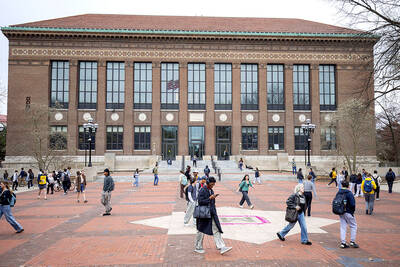In celebrity-obsessed Japan, with its conveyor belt of 15-minute stars, a fashion icon known as ‘Rola’ is blazing a meteoric trail at the forefront of a galaxy of mixed-race stars changing the DNA of Japanese pop culture.
Turn on the TV and there is no escaping the bubbly 24-year-old of Bengali, Japanese and Russian descent — she even dominates the commercial breaks. A marketing gold mine, Rola smiles celestially from giant billboards, her wide eyes and girlie pout grace magazine covers and she even greets you at vending machines.
However, Rola, who settled in Japan when she was nine, has done it by turning the entertainment industry on its head, her child-like bluntness slicing through the strict convention that governs Japanese society.

Photo: AFP
“Whenever people told me to speak politely, I never worried about it,” she told reporters in an interview. “I’m not talking down to anyone. I’m not a comedian; it’s just how I am. It’s just being open-hearted and trying to make people open theirs.”
However, it is not just her quirky charm that is breaking down barriers. Japan’s largely mono-ethnic society — a culture where skin whitening creams are still huge business — has long been mirrored by its entertainment industry.
Rola and host of others are beginning to change that.
A half-British singer and actress who performs as Becky is another superstar with model looks and a huge fan base in Japan, while half-French newscaster Christel Takigawa helped Tokyo win the 2020 Olympic vote as the city’s ambassador for “cool.”
Their rise to fame mirrors a shift in attitudes in Japan, which only opened its doors to the outside world in the middle of the 19th century and where foreigners — those without Japanese nationality, even if they were born here — make up less than 2 percent of a population of 127 million.
“Being of mixed race was once looked down upon,” sociologist Takashi Miyajima said. “Now, foreign entertainers are admired in Japan as something untouchable. You could even say they benefit from positive discrimination.”
Rarely now do you see TV shows without at least one haafu — a rough approximation of the Japanese pronunciation of “half,” used to denote someone of mixed race — such has been the shift.
“Young Japanese women want to be like Rola,” said psychologist Yoko Haruka, a regular on Japanese TV. “They buy the same clothes, bag. It’s like a cartoon world, the baby-face effect... She has the foreign look: long legs, small face, but because she is haafu, she’s not an object of envy at all. She’s an idol like Madonna was, but closer and easier to relate to.”
Rola’s trademark puffing of the cheeks, ditzy catchphrases, infectious giggle and carefree charm have helped make Japan’s most famous ‘It Girl’ a smash hit with legions of adoring fans.
Born of a Bangladeshi father and a half-Japanese, half-Russian mother, Rola’s eccentricities helped overcome the language barrier when she was young, when shoe once showed up at elementary school in pajamas she mistook for her new uniform.
When not shooting commercials for everything from cosmetics or beer to headache pills or battered octopus balls, Rola is at the gym — or fishing.
“When the next trends hit, the haafu boom will calm down a bit,” Haruka said. “But that might take a while.”
For now, Rola’s girl-next-door innocence continues to bewitch.
Asked to sum herself up in one word, she closes her eyes and offers: “A salmon, maybe. They’re not just tasty, they swim hard up rivers, so they’re tough little critters.”

Brazil, the world’s largest Roman Catholic country, saw its Catholic population decline further in 2022, while evangelical Christians and those with no religion continued to rise, census data released on Friday by the Brazilian Institute of Geography and Statistics (IBGE) showed. The census indicated that Brazil had 100.2 million Roman Catholics in 2022, accounting for 56.7 percent of the population, down from 65.1 percent or 105.4 million recorded in the 2010 census. Meanwhile, the share of evangelical Christians rose to 26.9 percent last year, up from 21.6 percent in 2010, adding 12 million followers to reach 47.4 million — the highest figure

A Chinese scientist was arrested while arriving in the US at Detroit airport, the second case in days involving the alleged smuggling of biological material, authorities said on Monday. The scientist is accused of shipping biological material months ago to staff at a laboratory at the University of Michigan. The FBI, in a court filing, described it as material related to certain worms and requires a government permit. “The guidelines for importing biological materials into the US for research purposes are stringent, but clear, and actions like this undermine the legitimate work of other visiting scholars,” said John Nowak, who leads field

‘THE RED LINE’: Colombian President Gustavo Petro promised a thorough probe into the attack on the senator, who had announced his presidential bid in March Colombian Senator Miguel Uribe Turbay, a possible candidate in the country’s presidential election next year, was shot and wounded at a campaign rally in Bogota on Saturday, authorities said. His conservative Democratic Center party released a statement calling it “an unacceptable act of violence.” The attack took place in a park in the Fontibon neighborhood when armed assailants shot him from behind, said the right-wing Democratic Center, which was the party of former Colombian president Alvaro Uribe. The men are not related. Images circulating on social media showed Uribe Turbay, 39, covered in blood being held by several people. The Santa Fe Foundation

NUCLEAR WARNING: Elites are carelessly fomenting fear and tensions between nuclear powers, perhaps because they have access to shelters, Tulsi Gabbard said After a trip to Hiroshima, US Director of National Intelligence Tulsi Gabbard on Tuesday warned that “warmongers” were pushing the world to the brink of nuclear war. Gabbard did not specify her concerns. Gabbard posted on social media a video of grisly footage from the world’s first nuclear attack and of her staring reflectively at the Hiroshima Peace Memorial. On Aug. 6, 1945, the US obliterated Hiroshima, killing 140,000 people in the explosion and by the end of the year from the uranium bomb’s effects. Three days later, a US plane dropped a plutonium bomb on Nagasaki, leaving abut 74,000 people dead by the